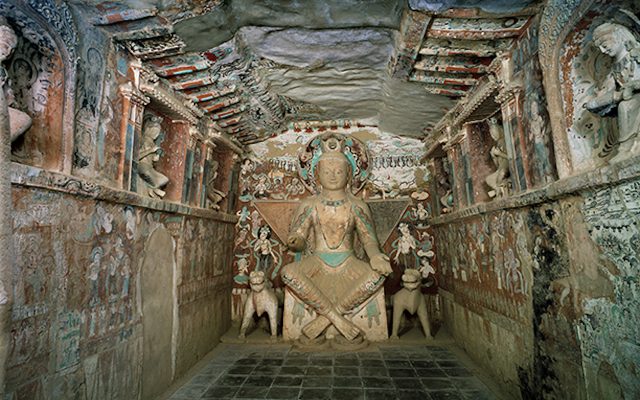Listed as a UNESCO World Heritage Site in 1987, they are located in the remote province of Gansu in northwest China. Specifically 25 km from the city of Dunhuang. At the time of the long caravans of the Silk Road, it was the oasis of the wealth of commercial exchanges. But not that the intensity of the cultural mix that took place there is spread out in colorful frescoes in hundreds of caves carved out over a thousand years by men of faith.
Smiles for eternity
From the Buddhas of the Three Kingdoms period (5th century) to those of the Yuan (1279-1368) passing through the quintessence of the Buddhist art of the Tang (618-907), they offer smiles to take away free of charge to the deepest self. The frescoes based on the sutras evoke many other things than religious precepts. It can be historical facts, such as the departure, in procession, of a delegation from the vintage towards barbaric lands. Or the picturesque scene showing the hitching of a camel to a cart leaving for an expedition.
At the end of the 14th century, all these marvels were abandoned, delivered to the winds of the sands, to torrential rains, to the floods of the Dachuan River. However, monks chose to continue living there until the beginning of the 20th century.
The sealed library
It is not known why this cave was walled up, but the preservation of the tens of thousand of documents it contained has made countless happy people among scientific communities around the world. Some are under study, even today, and high-level experts are collaborating with the Dunhuang Academy for the greater good of the site. Its digitization, a colossal task, is in fact in progress.
The Taoist monk who discovered the cave in 1900 made himself its guardian and informed whom it may concern. Without any reaction. In contrast, Indiana Jones’ forerunners rushed to deal with so-called “Abbot Wang.” , Sanskrit… statuettes, paintings on silk and other objects representative of exchanges between China, India and Central Asia. To the great satisfaction of the Guimet Museum and the National Library of France (digitized manuscripts are visible on its website). As for the British museum, it is to the archaeologist Aurel Stein that it owes the oldest printed book in the world: the Diamond Sutra, which dates from the year 968.
Meanwhile, Master Tang, aware of the inestimable value of the place, began to raise funds to save the caves from annihilation, and one thing leading to another, that is what happened.
The caves in figures
The Mogao site has 492 caves and rock sanctuaries retaining 45,000 m2 of wall paintings and some 2,000 statues and other works of art. A few spaces were opened to the public in 1979. The main cliff looks like a predominantly red frontispiece divided into five floors. The caves communicate with each other via walkways arranged at different heights on the rock wall. It’s quite a pipe-breaker as a labyrinth, but how not to imagine a super zen monk-adventurer working at the risk of his life on this absolutely fabulous great work. To get in, you line up, maybe you don’t know you’re counted…but a yellow light flashes on the supervisor’s screen when the authorized humidity level is reached. Humidity kills murals and countering it requires know-how that has required years of development. Only five caves (organized in rotation) and two exhibition halls are normally accessible. They are more numerous during Chinese holidays.
The Chinese, as we know, cherish their cultural heritage.


